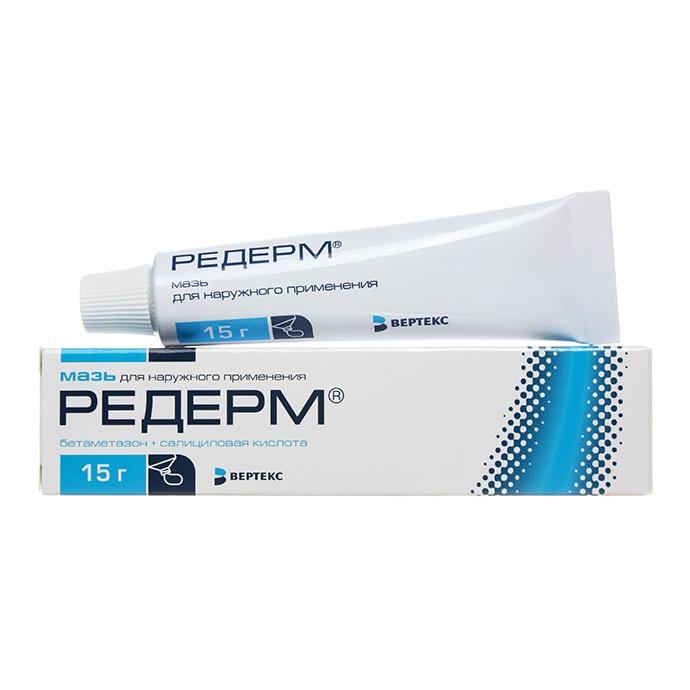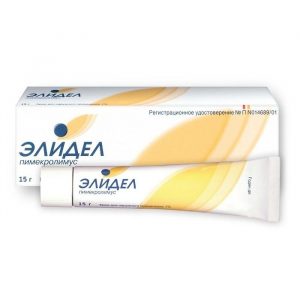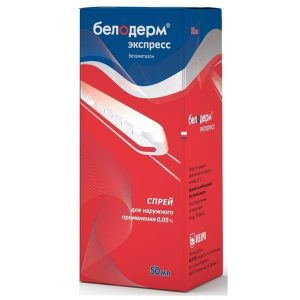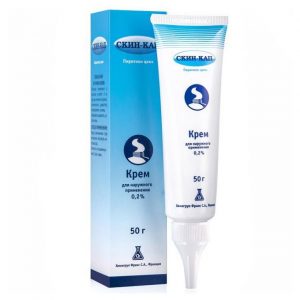Description
Latin name
REDERM
Indications
therapy of subacute and chronic dermatoses accompanied by hyperkeratosis and desquamation: – psoriasis
– dyshidrotic dermatitis
– eczema
– neurodermatitis
– lichen planus
– ichthyosis and ichthyotic skin lesions
– atopic dermatitis
– diffuse common dermatitis – simple and common acute allergic dermatitis lichen (limited neurodermatitis)
– dermatoses that cannot be treated by other corticosteroids (especially red warty lichen)
– skin dyshidrosis.
Contraindications
hypersensitivity
open wounds
bacterial, viral and fungal skin diseases (pyoderma, syphilis, tuberculosis of the skin, chickenpox, herpes, actinomycosis, blastomycosis, sporotrichosis)
post-vaccination skin reactions
perioral dermatitis
rosacea
trophic ulcers in the presence of chronic venous insufficiency
skin tumors (skin cancer, nevus, atheroma, epithelioma, melanoma, childhood sarcoma, childhood 2 years.
Precautions
Hepatic insufficiency childhood (over 2 years) long-term therapy, especially with the use of occlusive dressings.
Special instructions
Avoid contact with the eyes. Do not use on the skin near the eyes and mucous membranes. The drug is not intended for use in ophthalmology.
With prolonged treatment, applying the drug to large surfaces of the skin, using occlusive dressings, systemic absorption of corticosteroids is possible.
Long-term use on the skin of the face is not recommended – it is possible the development of dermatitis such as rosacea, perioral dermatitis, skin atrophy and acne should be avoided in the anogenital area.
Ointment is most suitable for the treatment of patients with dry and brittle skin.
If signs of hypersensitivity or skin irritation associated with the use of the drug are noted, treatment should be discontinued and adequate therapy should be selected for the patient.
With prolonged use of the drug, its withdrawal should be carried out gradually.
Composition
Ointment for external use 100 g
active substances:
betamethasone 0.05 g
(as betamethasone dipropionate) srdlp 3 Excipients:
liquid paraffin (petroleum jelly)
petroleum jelly (white petrolatum, soft white paraffin)
Dosage and Administration
Externally.
Apply to affected areas at the rate of: a 0.5 cm long ointment column on a skin area of ² ¹ ² ¹approximately 7 ² 7 cm, rubbing slightly, with a thin layer 2 times a day. Another frequency of use can be determined by a doctor based on the severity of the disease. In mild cases, the ointment is sufficient to apply, as a rule, 1 time per day for more severe lesions, more frequent use may be necessary.
If necessary, apply occlusive dressings that change every 24 hours.
The duration of treatment depends on the effectiveness and tolerability of therapy and is 2 ² 4 weeks.
If clinical improvement does not occur, the diagnosis must be clarified.
Special Patient Groups
Children. For children from 2 years of age, the drug is prescribed only according to strict indications and under medical supervision, because possible development of systemic side effects associated with betamethasone. The duration of treatment should be as short as possible.
When using the drug on large surfaces and / or under an occlusive dressing, it is possible to suppress the function of the hypothalamic-pituitary-adrenal system and the development of symptoms of hypercorticism, there may be a decrease in the excretion of growth hormone, an increase in ICP.
Side effects
Burning, irritation, dryness, hypopigmentation, itchy skin, folliculitis, hypertrichosis, dermatitis, acne-like rashes.
When using occlusive dressings – maceration of the skin, striae, skin atrophy, secondary infection, prickly heat.
With prolonged use – skin atrophy, local hirsutism, telangiectasia, purpura, hypopigmentation, hypertrichosis.
When applied to large surfaces, systemic manifestations of side effects of corticosteroids (growth retardation, Itsenko-Cushing’s syndrome, increased intracranial pressure after treatment, hyperglycemia, glucosuria, hypokalemia, increased blood pressure) or salicylates (pallor, increased fatigue, drowsiness, hyperventilation on the background of tachypnea , nausea, vomiting, hearing loss, confusion).
Overdose
Symptoms: an acute overdose is unlikely, however, with excessive or prolonged use of the drug, a chronic overdose is possible, accompanied by signs of hypercorticism – hyperglycemia, glucosuria, reversible inhibition of adrenal cortex function, manifestation of Cushing’s syndrome.
Treatment: appropriate symptomatic treatment is indicated. In case of chronic toxic effects, gradual discontinuation of the drug is recommended.
Storage conditions
At a temperature not exceeding 25 ° C.
Keep out of the reach of children.
Expiration
2 years
Deystvuyuschee substances
betamethasone, salicylic acid
dosage form
ointment
Vertex, Russia




